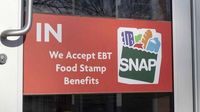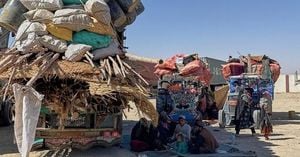As September 2025 begins, millions of Americans are bracing for changes to the nation’s largest food assistance program. In California, the CalFresh benefit distribution schedule is rolling out as usual, with funds deposited to Electronic Benefit Transfer (EBT) accounts in a steady rhythm from September 1 through September 10. But beneath this familiar routine lies a wave of anxiety, as federal legislation threatens to reshape the landscape of food assistance across the country, with ripple effects reaching from sprawling cities like Los Angeles to the heart of Clark County, Nevada.
CalFresh, California’s version of the federal Supplemental Nutrition Assistance Program (SNAP), serves as a lifeline for more than five million residents. According to recent statistics cited by local media outlets, this makes it the largest nutrition assistance initiative in the United States. Each year, over twelve billion dollars in federal funding flow into California’s economy through CalFresh, helping families, seniors, and individuals with limited incomes put food on the table.
The process for receiving CalFresh benefits is straightforward, at least on paper. Deposits are made according to the last digit of each recipient’s case number, with funds released before midnight on the corresponding date. For September 2025, the schedule runs like clockwork—case numbers ending in 1 receive benefits on September 1, those ending in 2 on September 2, and so on, until everyone is accounted for by September 10.
The maximum monthly benefit amounts for CalFresh in 2025 mirror federal SNAP limits and are determined by household size. A single-person household can receive up to $291, while a family of four is eligible for $975. Larger families get even more, with an additional $220 for each person beyond eight members. These numbers are reviewed and updated annually, ensuring they keep pace with the cost of living—at least in theory.
But for many, these benefits are already stretched thin. The demographic profile of CalFresh recipients highlights the program’s critical role in addressing food insecurity among California’s diverse population. The Latino community, for example, represents around 60% of beneficiaries, despite making up just 39% of the state’s population. Studies show that nearly half of low-income Latino households report difficulty obtaining enough food, a rate slightly higher than that of all low-income adults statewide.
Yet, just as these families and individuals rely on CalFresh to make ends meet, sweeping changes are on the horizon. In 2025, Congress passed what’s being called the Republican reconciliation bill—officially named the One Big Beautiful Bill Act. This legislation, according to Las Vegas Sun and other regional sources, will enact the largest cuts in SNAP’s history, slashing approximately $186 billion in funding over the next decade. The most significant changes are set to take effect in January 2027, and the impact is already being felt in communities across the West.
One of the most contentious aspects of the new law is its shift in responsibility from the federal government to the states. States like California and Nevada will be required to cover funding shortfalls resulting from federal cuts, or else pass the reductions directly onto beneficiaries. Early estimates suggest this could mean lower monthly benefits for millions of Americans. Nationally, the program could lose up to $300 billion, with California alone facing the loss of billions in support for its most vulnerable residents.
In Nevada, the consequences are particularly acute. According to reporting by the Las Vegas Sun, more than 100,000 Nevadans are at risk of losing their SNAP benefits. In Clark County, the state’s most populous region, about one in six people is food insecure. Sharon Studer, a 69-year-old Las Vegas resident, knows this struggle all too well. After losing her husband in 2023, Studer entered what she described as “survival mode,” relying on Meals on Wheels and her shrinking SNAP benefits to get by.
Studer’s story is echoed by Sara Meyer, vice president at Catholic Charities of Southern Nevada, which operates the local Meals on Wheels program. “The uncertainty related to funding leaves our seniors, our people coming to the food pantry, our refugees wondering what’s next for them,” Meyer told the Las Vegas Sun. The waiting list for Meals on Wheels is growing by the day, she added, sometimes reaching as many as 1,000 people. Federal, state, and local governments currently cover 45% of each meal’s cost, leaving the remaining 55% to be shouldered by Catholic Charities itself.
The One Big Beautiful Bill Act introduces new work requirements for SNAP recipients aged 55 to 64—a group previously exempt from such conditions. For organizations like Meals on Wheels, which serves seniors 60 and older, the new rules could have devastating effects. “The work requirements and the paperwork that goes along with it are meant for people either not to sign up, to intimidate them or make it just another hurdle that they can’t get over,” said U.S. Senator Jacky Rosen of Nevada during a recent visit with Studer. Rosen warned that the change will increase food insecurity among the elderly, adding, “more people will get sick.”
Senator Catherine Cortez Masto, also of Nevada, highlighted another major concern: the shifting of SNAP’s administrative costs onto states. Starting in the 2027 financial year, Nevada will see its share of these costs jump from 50% to 75%. “Instead of giving more resources to the states so they can shoulder that new burden, it actually takes away from the states,” Cortez Masto said. “While the state figures out how to close that gap … organizations like Three Square are left with really too much uncertainty.”
The challenge for local food banks is daunting. Beth Martino, CEO of Three Square, pointed out that SNAP provides nine meals for every one distributed by local food banks. “The work that Three Square does to put food on people’s table is incredibly important, but for every meal that Three Square distributes, SNAP provides nine,” Martino said. She also emphasized SNAP’s economic impact, citing a U.S. Department of Agriculture study showing that every dollar invested in the program yields $1.54 in economic activity.
Community organizations are scrambling to adapt. Brooke Neubauer, founder of The Just One Project, said her group is working with state officials to help Nevadans retain their SNAP benefits. “The reenrollment process is going to be challenging with the new requirements,” Neubauer said. “We are ready to create programs to help support these people come into The Just One Project, get wraparound services, work on workforce development and maintain their SNAP benefits.”
Back in California, the demographic and financial stakes are just as high. Latino households, already facing higher rates of food insecurity, risk being disproportionately affected by the new cuts and requirements. As the implementation date for the new rules draws closer, advocates warn that millions could see their benefits reduced or lost altogether, further straining food banks and charitable organizations already stretched to the limit.
For recipients like Sharon Studer, the changes are more than just numbers on a spreadsheet—they’re a daily reality. “Sometimes my colleagues in Washington, they’re so worried about the numbers that they forget there’s a person behind each and every one of these,” Senator Rosen told Studer. The coming years will test not just the resilience of America’s food assistance programs, but the country’s willingness to protect its most vulnerable citizens in times of need.




